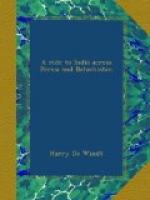“Don’t be alarmed; they are the proverbial rum ’uns to look at,” said our host, who would not hear of our setting out without saddle-bags crammed with good things: cold meat, sardines, cigarettes, a couple of bottles of brandy, and a flask of Russian vodka. But for these we must literally have starved en route.
“Good-bye. Good luck to you!” from the colonel.
“En avant!” cries Gerome, with a deafening crack of his heavy chapar whip. We are both provided with this instrument of torture—a thick plaited thong about five feet long, attached to a short thick wooden handle, and terminating in a flat leathern cracker of eight or ten inches. A cut from this would make an English horse jump out of his skin, but had little or no effect on the tough hides of our “chapar” ponies. The snow is almost up to the knees of the latter as we labour through the gateway and into the narrow street. Where will it be on the Kharzan Pass?
Resht is picturesquely situated. It must be a lovely place in summer-time, when fertile plains of maize, barley, and tobacco stretch away on every side, bounded by belts of dark green forest and chains of low well-wooded hills, while the post-road leads for miles through groves of mulberry trees, apple orchards, and garden-girt villas, half hidden by roses and jasmine. But this was hardly a day for admiring the beauties of nature. Once out of the suburbs and in the open country, nothing met the eye but a dreary wilderness of white earth and sullen grey sky, that boded ill for the future. The cold was intense. Although dressed in the thickest of tweeds and sheepskin jacket, sable pelisse, enormous “bourka,” and high felt boots, it was all I could do to keep warm even when going at a hand gallop, varied every hundred yards or so by a desperate “peck” on the part of my pony.
The first stage, Koudoum, five farsakhs from Resht, was reached about three o’clock in the afternoon. This was my first experience of a Chapar khaneh. The Shagird informed us that it was considered a very good one, and was much frequented by Europeans in summer-time—presumably, judging from the holes in the roof, for the sake of coolness. Let me here give the reader a brief description of the accommodation provided for travellers by his Imperial Majesty the Shah. The Koudoum Chapar khaneh is a very fair example of the average Persian post-house.
Imagine a small one-storied building, whitewashed, save where wind and rain have disclosed the brown mud beneath. A wooden ladder (with half the rungs missing) leads to the guest-chamber, a large bare room, devoid of furniture of any kind, with smoke-blackened walls and rotten, insecure flooring. A number of rats scamper away at our approach. I wonder what on earth they can find to eat, until Gerome points out a large hole in the centre of the apartment. This affords an excellent view of the stables, ten or twelve feet below, admitting, at the same time,




